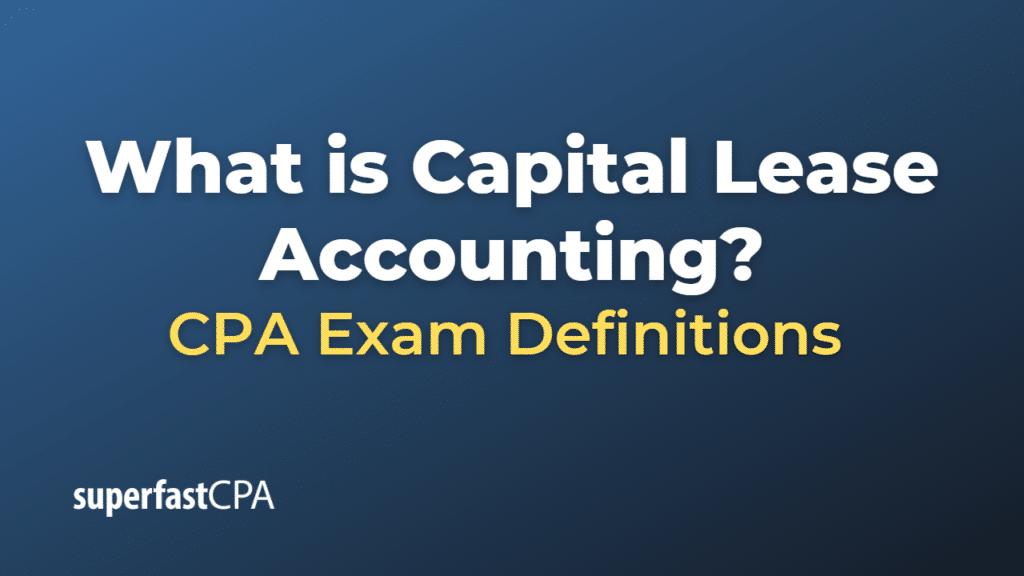Capital Lease Accounting
Capital lease accounting, also known as finance lease accounting, refers to the accounting treatment for leases that are considered to be a financing arrangement in which the lessee (the party using the asset) effectively acquires the risks and rewards of ownership of the leased asset. In a capital lease, the lessee essentially treats the leased asset as if it were purchased, even though the legal ownership remains with the lessor (the party providing the asset).
Capital leases are distinguished from operating leases, where the lessee only has the right to use the asset for a specific period and does not assume the risks and rewards of ownership. The classification criteria for capital leases can vary depending on the accounting standards being used (e.g., US GAAP or IFRS).
Under capital lease accounting, the lessee records the leased asset as a fixed asset on its balance sheet and recognizes a corresponding lease liability. The lessee also records depreciation expense for the leased asset over its useful life and interest expense on the lease liability.
Here’s how capital lease accounting works for the lessee:
- At the inception of the lease, the lessee records the leased asset at the present value of the minimum lease payments or the fair market value of the asset, whichever is lower. A corresponding lease liability is also recorded.
- Over the lease term, the lessee records depreciation expense on the leased asset, typically using the straight-line method over the useful life of the asset or the lease term, depending on the lease agreement and accounting standards.
- The lessee also records interest expense on the lease liability, calculated using the effective interest method. The lease payments are allocated between principal repayment (reducing the lease liability) and interest expense.
- At the end of the lease term, the leased asset is fully depreciated, and the lease liability is fully repaid, resulting in no net impact on the lessee’s balance sheet.
Capital lease accounting ensures that the substance of the leasing arrangement is accurately reflected in the financial statements of the lessee, capturing the financing nature of the transaction and its impact on the lessee’s assets, liabilities, and expenses.
Example of Capital Lease Accounting
Let’s consider a fictional example involving a company called “MegaMachinery Inc.” that enters into a capital lease agreement.
MegaMachinery is a manufacturing company that needs a specialized machine for its production process. The machine has a fair market value of $500,000, and MegaMachinery enters into a 5-year capital lease agreement with a lessor to acquire the use of the machine. The annual lease payments are $120,000, and the interest rate implicit in the lease is 6%.
Here’s how MegaMachinery would account for the capital lease:
- At the inception of the lease, MegaMachinery calculates the present value of the minimum lease payments. Assuming a 6% annual interest rate, the present value of five annual lease payments of $120,000 would be approximately $482,315. MegaMachinery records the leased machine as a fixed asset on its balance sheet at this amount and also recognizes a corresponding lease liability of $482,315.
- Over the 5-year lease term, MegaMachinery records depreciation expense on the leased machine. Using the straight-line method, the annual depreciation expense would be $482,315 / 5 years = $96,463.
- MegaMachinery also records interest expense on the lease liability using the effective interest method. In the first year, the interest expense would be 6% * $482,315 = $28,939. The total lease payment in the first year is $120,000, so the principal repayment would be $120,000 – $28,939 = $91,061. The lease liability would be reduced by the principal repayment amount to $391,254 ($482,315 – $91,061).
- This process continues for the remaining lease term, with MegaMachinery recording depreciation expense, interest expense, and principal repayments each year. At the end of the 5-year lease term, the leased machine is fully depreciated, and the lease liability is fully repaid.
In this example, MegaMachinery’s capital lease accounting reflects the financing nature of the lease agreement, recognizing the leased machine as an asset and a corresponding lease liability on its balance sheet. The depreciation and interest expenses recorded over the lease term capture the costs associated with using and financing the leased machine.













